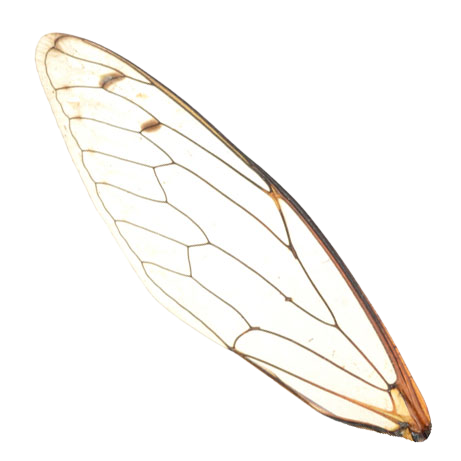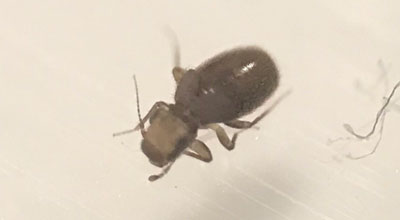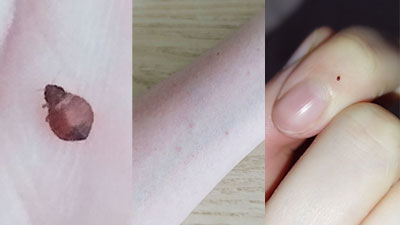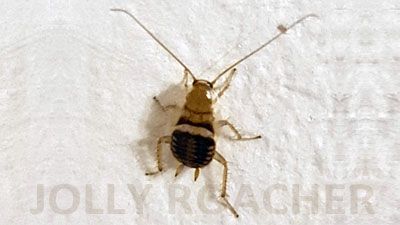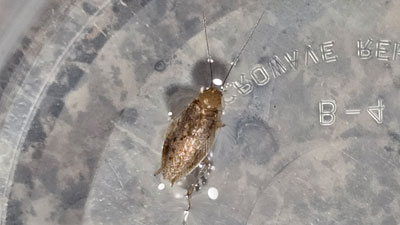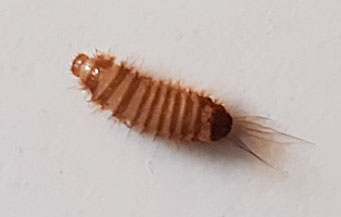Look at what insects you can find in an apartment in a trinket box – these are the larvae of the khapra beetle, and they once again confirm their worldwide fame as one of the most omnivorous creatures in the world:
It is not clear what these larvae can eat in a box with children’s trinkets – matches, threads, scraps of fabric and decorative candles?
But it turned out that along with all this inedible trash in the box there was also a “necklace” of dried rose hips which the child had made for his mother. Mom couldn’t throw away this kid-made jewelry – after all, the three-year-old kid made it with his own hands to please her – and just left it in the box.
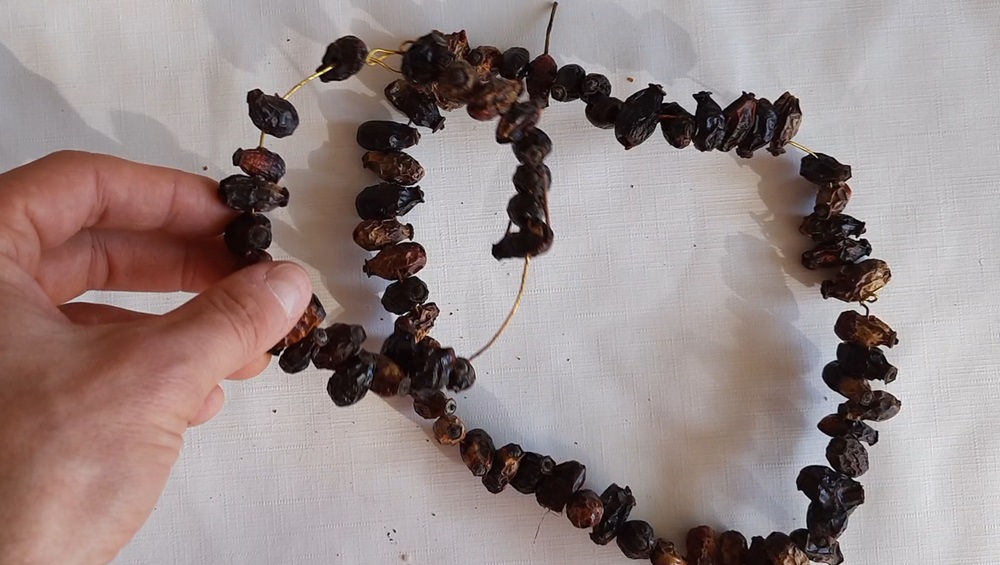
And somehow the eggs of a khapra beetle ended up on one of the fruits. Perhaps they were there even before the child picked the fruit. Or perhaps a caring mother beetle found them already in a box in the apartment and laid eggs on them, expecting that the stock of these berries would be enough for her brood. And that was enough!
These larvae have already reached almost their full size. They are about 5-6 mm long and should not grow any larger. Having reached such sizes, they crawl away from their food sources and look for convenient places for pupation and further metamorphosis.
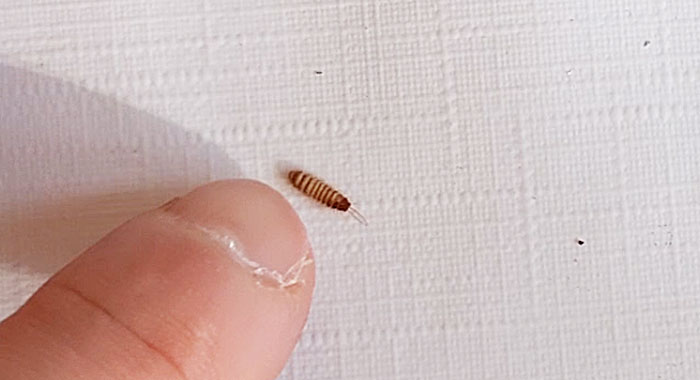
It is impossible to say with absolute certainty that these are the larvae of the cabinet beetle Trogoderma granarium, because I did not find adults, but it is by them that the species is identified. However, the larvae themselves look typical of the genus Trogoderma, and the species Trogoderma granarium is the most widespread and numerous in this genus. Therefore, it is most likely that we are looking at the larvae of the khapra beetle.
Could the khapra beetle larvae feed on such indigestible food?
Since there are no other edible products in this box, we can be sure that the larvae here fed on these dry rose hips. This is all the more obvious from the fruits themselves: they are all damaged, with numerous holes in the rind, many of them have eaten out the middle and damaged seeds.
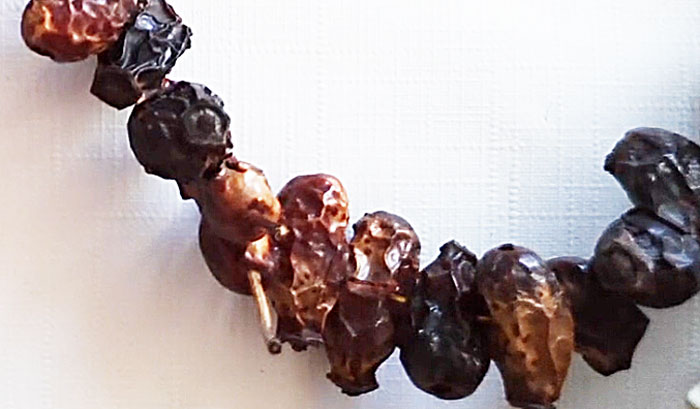
At the same time, these berries do not look particularly appetizing. They are dry, there is very little soft tissue inside them, and in fact they are hard seeds covered with rind. But this is apparently enough for the cabinet beetle larvae.
Indeed, natural and quite suitable food for them is grain, flour and various dry plant products. In warehouses, khapra beetle larvae actively damage stocks of peanuts, nuts, dried fruits, tea, cocoa, and readily eat copra. And in houses, apartments, museums and schools they can spoil herbariums and various botanical and biological collections.
Small but vicious pests…
Of course, due to such food preferences, such larvae very often cause harm in various enterprises – in warehouses, elevators, processing plants and plantations. Moreover, because of their feeding indiscriminateness and readiness to damage any products in any storage facilities, as well as due to their high fecundity, they are considered very dangerous pests and are classified as quarantine species: many cargoes in which these larvae may be found are checked at customs terminals upon arrival to a new country. But this does not help much: from its original range in India, this species has actively spread with goods and products almost all over the world. And now we find it in the northern Black Sea region in dry rose hips.
Interestingly, the cabinet beetle larvae can eat grain with very low moisture content – down to 6%. Very few other dermestids and very few other species of beetles can feed on such dry food, and therefore in many countries of Southern Europe, Asia and Oceania this species is the main pest of warehouse stocks.
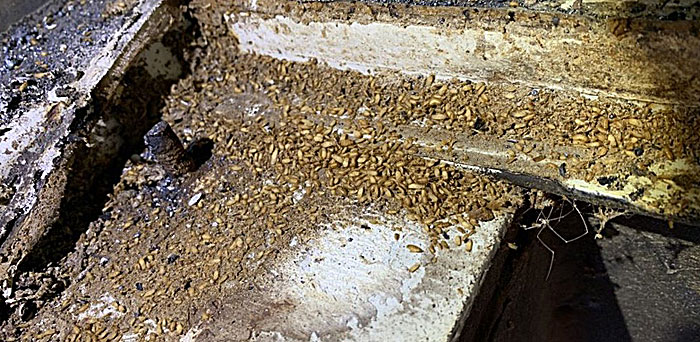
Because of such harmfulness, this species is included in the top 100 worst invasive species in the world.
Note
In some granaries in Turkey, Trogoderma granarium is responsible for losses of up to 70% of batches of stored grain. In many breweries, its larvae spoil entire batches of stored malt, turning the grains into small, unusable dust.
Nevertheless, these same larvae do not disdain food of animal origin: they were found on the corpses of mice in the same warehouses where they damaged grain, on the corpses of birds and in heaps of the remains of other insects.
All the products that khapra beetle larvae can find, they slowly eat, leaving in their place dust-like rot mixed with their own feces.
In many European countries, the khapra beetle is classified as a quarantine pest. If custom inspectors detect it in certain shipments, the cargoes are blocked for further transportation and undergo quarantine with pesticide treatment.
How to distinguish khapra beetle larvae from larvae of other species of skin beetles?
Look at the appearance of the larvae from the very first video. Although they generally look typical of skin beetle larvae, they have morphological features that can be used to distinguish them from larvae of other species.
First of all, they are quite long and thin, and their hairs are neatly “combed” along the body and form a thin brush at the end of the abdomen.
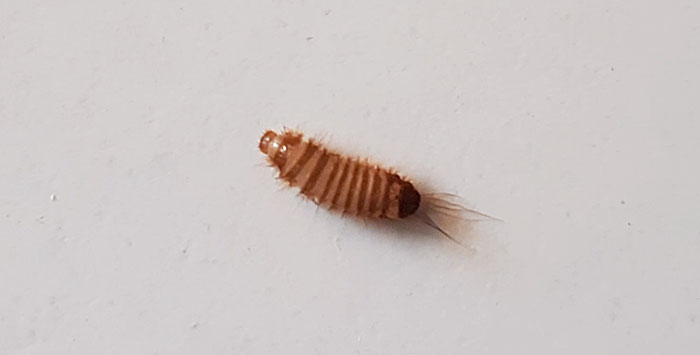
This “hairstyle” and elongated body distinguish them from Anthrenus larvae – shorter, with longer bristles, that, on the contrary, stick out perpendicular to the body and visually increase the width of the insect.
A typical Anthrenus larva is shown in this video:
Next, these larvae differ from the larvae of more meat-eating species such as the black larder beetle or Dermestes frischii by their lighter coloration. Although it is known that in most skin beetles the larvae within one species can vary greatly in color depending on the diet: the more “light” and plant foods they eat, the lighter their coloration.
For example, this is what black larder beetle larvae look like on the corpse of a fox:
It is quite possible that our larvae from the box would have been much darker if they were eating here not berries, but dried meat or a collection of some insects.
As it is, the larvae of the black larder beetle on their typical food – carrion – are dark, almost black, while the larvae of the Trogoderma granarium on their typical food – dried berries – are light brown.
Adults of the khapra beetle are normally reddish-gray, densely covered with short hairs, 2-3 mm long. However, this species is known for the wide variability in color of adult individuals: in beetles of different populations, dark or light spots and various wavy stripes may appear on the elytra, and the color background varies from light brown to almost black. Therefore, even specialists, when meeting these beetles, reliably identify them only under a microscope.

So be prepared that these hairy larvae may accidentally appear in your home. If you come across them, try to find all the places where they accumulate and the products which they are eating and spoiling. All such foods should be thrown away, and in the future you have better not buy groceries and dried fruits for long-term storage. The longer you keep food at home, the more likely that there will be something in it – if not khapra beetle larvae, then anyone else – grinders, moths, or granary mites.
And if you already have some arthropods in your food but can’t recognize it, then take a photo or shoot a video with it and send it to me for identification. Will figure out what you’ve sheltered in your home!
